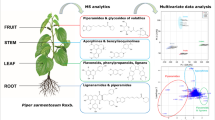Abstract
Phytochemical constituents were isolated from the aerial parts of Taraxacum coreanum (Asteraceae) by repeated column chromatography and prep-HPLC. Their structures were identified as β-sitosterol (1), daucosterol (2), taraxasteryl acetate (3), chrysoeriol (4), diosmetin (5), luteolin (6), luteolin-7-O-glucoside (7), esculetin (8), and 5-hydroxypyrrolidin-2-one (9) by the interpretation of spectroscopic analyses including MS, 1H-, and 13C-NMR. This is the first report on the isolation of compounds 1-9 from T. coreanum. Among the compounds, 5 and 9 were isolated for the first time from Taraxacum.
Similar content being viewed by others
References
Akashi T, Furuno T, Takahashi T, and Ayabe SI (1994) Biosynthesis of triterpenoids in cultured cells, and regenerated and wild plant organs of Taraxacum officinale. Phytochemistry 36, 303–308.
Chang IM, Yun HS, and Yamasaki K (1981) Revision of 13C NMR assignments of β-sitosterol and β-sitosteryl-3-O-β-Dglucophyranoside isolated from Plantago asiatica seed. Kor J Parmacogn 12, 12–24.
Chow YL and Quon HH (1970) Biogenetically related triterpenes from Elateriospermum tapos bark. Phytochemistry 9, 1151–1152.
Cussans NJ and Huckerby TN (1975) Carbon-13 NMR spectroscopy of heterocyclic compounds-IV: A 20 MHz study of chemical shifts and carbon-proton coupling constants in a series of hydroxy, methoxy and glucosyl coumarins. Tetrahedron 31, 2719–2726.
Domínguez XA, Rojas P, Dueñas Wiarco MDC, and Escarria S (1973) Epi-friedelinol and taraxasterol acetate from Eupatorium azureum. Phytochemistry 12, 224.
Faber K (1958) Dandelion-Taraxacum officinale Weber. Pharmazie 13, 423–436.
Gurib-Fakim A (2006) Medicinal plants: traditions of yesterday and drugs of tomorrow. Mol Asp Med 27, 1–93.
Hartwig UA, Maxwell CA, Joseph CM, and Phillips DA (1990) Chrysoeriol and luteolin released from Alfalfa seeds induce nod genes in Rhizobium meliloti. Plant Physiol 92, 116–122.
Hänsel R, Kartarahardja M, Huang JT, and Bohlmann F (1980) Sesquiterpenlacton-β-D-glucopyranoside sowie ein neues Eudesmanolid aus Taraxacum officinale. Phytochemistry 19, 857–861.
Hiermann A (1992) Taraxacum. In Hagers Handbuch der Pharmazeutischen Praxis, Hänsel R, Keller K, Rimpler H, and Schneider G (eds.), 6, pp. 897–904, Springer-Verlag Berlin Heidelberg, Germany.
Ho C, Choi EJ, Yoo GS, Kim KM, and Ryu SY (1998) Desacetylmatricarin, an anti-allergic component from Taraxacum platycarpum. Planta Med 64, 577–578.
Hock ILI (1994) Taraxacum officinale WEBER (Dandelion): in vivo culture, micropropagation, and the production of volatile metabolites. In Biotechnology In Agriculture And Forestry 26, Medicinal And Aromatic Plants, Bajaj YPS (ed.), 6, pp. 356–369, Springer-Verlag Berlin Heidelberg, Germany.
Jung MJ, Kang SS, Jung HA, Kim GA, and Choi JS (2004) Isolation of flavonoids and cerebroside from the stem bark of Albizzia julibrissin. Arch Pharm Res 27, 593–599.
Kirchner A (1955) Der gemeine Löwenzahn, Taraxacum officinale Web. Der Versuch einer Monographie in landwirtschaftlicher Betrachtung. Zeitschrift für Acker- und Pflanzenbau 99, 488–518.
Kisiel W and Barszcz B (2000) Further sesquiterpenoids and phenolics from Taraxacum officinale. Fitoterapia 71, 269–273.
Kisiel W and Michalska K (2006) Matricarin-type guaianolides from Taraxacum bessarabicum and their chemotaxonomic significance. Biochem Syst Ecol 34, 356–359.
Lee HH and Lee SY (2008) Cytotoxic and antioxidant effects of Taraxacum coreanum Nakai and T. officinale Web. extracts. Korean J Medicinal Crop Sci 16, 79–85.
Leu YL, Wang YL, Huang SC, and Shi LS (2005) Chemical constituents from roots of Taraxacum formosanum. Chem Pharm Bull 53, 853–855.
Michalska K and Kisiel W (2003) Sesquiterpene lactones from Taraxacum obovatum. Planta Med 69, 181–183.
Ockendon DJ, Alston RE, and Naifeh K (1966) The flavonoids of Psoralea (Leguminosae). Phytochemistry 5, 601–608.
Razdan TK, Qadri B, Harkar S, and Waight ES (1987) Chromones and coumarins from Skimmia laureola. Phytochemistry 26, 2063–2069.
Rubinstein I, Goad LJ, Clague ADH, and Mulheirn L (1976) The 200 MHz spectra of phytosterols. Phytochemistry 15, 195–200.
Staubmann R, Zsilavecz MS, Hiermann A, and Kartnig T (1999) A complex of 5-hydroxypyrrolidin-2-one and pyrimidine-2,4-dione isolated from Jatropha curcas. Phytochemistry 50, 337–338.
Subramanian SS and Nair AGR (1972) Flavonoids of the leaves of Pedalium murex. Phytochemistry 11, 464–465.
Sweeney B, Vora M, Ulbricht C, and Basch E (2005) Evidencebased systematic review of dandelion (Taraxacum officinale) by natural standard research collaboration. J Herb Pharmacother 5, 79–93.
Williams CA, Harborne JB, and Crosby TS (1976) Tricetin, diosmetin and luteolin sulphates in leaves of Lachenalia unifolia. Phytochemistry 15, 349–350.
Williams CA, Goldstone F, and Greenham J (1996) Flavonoids, cinnamic acids and coumarins from the different tissues and medicinal preparations of Taraxacum officinale. Phytochemistry 42, 121–127.
Wolbis M, Krolikowska M, and Bednarek P (1993) Polyphenolic compounds in Taraxacum officinale. Acta Polon Pharmaceut Drug Res 50, 153–158.
Xiong J, Ma Y, and Xu Y (1992) Diterpenoids from Siegesbeckia pubescens. Phytochemistry 31, 917–921.
Zhang A, Zhao X, Chen H, and Liu L (2007) Chemical constituents from the ascomycetous fungus Tuber indicum. Chem Nat Comp 43, 349–350.
Author information
Authors and Affiliations
Corresponding author
Rights and permissions
About this article
Cite this article
Lee, S., Han, S., Kim, H.M. et al. Isolation and identification of phytochemical constituents from Taraxacum coreanum . J. Korean Soc. Appl. Biol. Chem. 54, 73–78 (2011). https://doi.org/10.3839/jksabc.2011.010
Received:
Accepted:
Issue Date:
DOI: https://doi.org/10.3839/jksabc.2011.010




